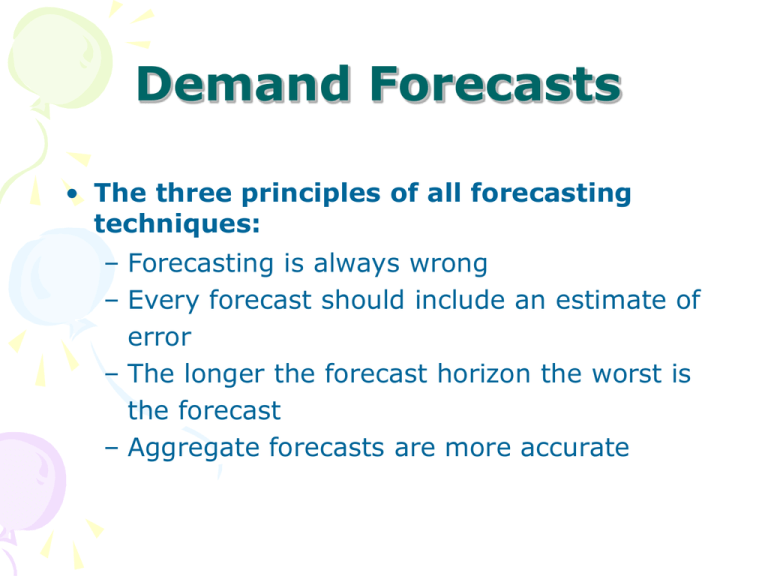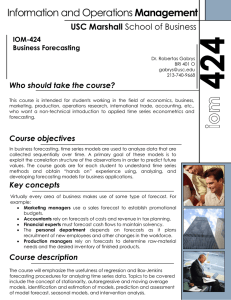Forecasting Techniques.ppt
advertisement

Demand Forecasts • The three principles of all forecasting techniques: – Forecasting is always wrong – Every forecast should include an estimate of error – The longer the forecast horizon the worst is the forecast – Aggregate forecasts are more accurate Two comments frequently made by managers • We’ve got to have better forecasts • I don’t trust these forecasts or understand where they came from • These comments suggest that forecasts are held in disrepute by many managers The truth about forecasts • They are always wrong • Sophisticated forecasting techniques do not mean better forecasts • Forecasting is still an art rather than an esoteric science • Avoid single number forecasting – Single number substitutes for the decision Selecting a forecasting technique • What is the purpose of the forecast? • How is it to be used? • What are the dynamics of the system for which forecast will be made? • How important is the past in estimating the forecast? Forecasting Techniques • Judgmental methods Qualitative • Market research methods • Time series methods Quantitative • Casual methods Judgmental methods • Sales-force composite • Panels of experts • Delphi method Market research method • Markey testing • Market survey Time Series methods • Moving average • Exponential smoothing • Trend analysis • Seasonality – Use de-seasonalized data for forecast – Forecast de-seasonalized demand – Develop seasonal forecast by applying seasonal index to base forecast Components of an observation Observed demand (O) = Systematic component (S) + Random component (R) Level (current deseasonalized demand) Trend (growth or decline in demand) Seasonality (predictable seasonal fluctuation) Causal methods • Single Regression analysis • Multiple Regression analysis Error measures • MAD • Mean Squared Error (MSE) • Mean Absolute Percentage Error (MAPE) • Bias • Tracking Signal Collection and preparation of data • Record data in the same terms as needed for forecast – Demand vs. shipment – Time interval should be the same • Record circumstances related to data • Record demand separately for different customer groups Time Series Forecasting Quarter II, 1998 III, 1998 IV, 1998 I, 1999 II, 1999 III, 1999 IV, 1999 I, 2000 II, 2000 III, 2000 IV, 2000 I, 2001 Demand Dt 8000 13000 23000 34000 10000 18000 23000 38000 12000 13000 32000 41000 Forecast demand for the next four quarters. Time Series Forecasting 50,000 40,000 30,000 20,000 10,000 0 , 2 7, 3 7, 4 8, 1 8, 2 8, 3 8, 4 9, 1 9, 2 9, 3 9, 4 0, 1 7 9 9 9 9 9 9 9 9 9 9 9 0







